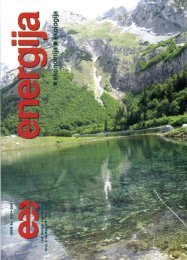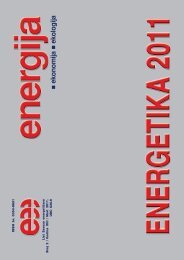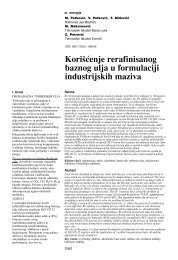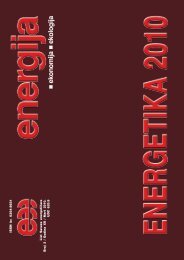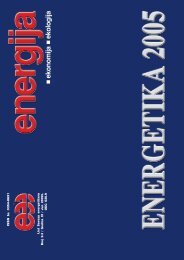ekonomija
2009-5
2009-5
- No tags were found...
You also want an ePaper? Increase the reach of your titles
YUMPU automatically turns print PDFs into web optimized ePapers that Google loves.
energijaFig 2 Scheme of house installed grid-connected PV solar system(about 15 years ago) was designed inthe thyristor technology, but today’sinverters are more complex electronicdevices designed to fulfil various specificdemands for GC PV applications,with very high DC/AC transformationefficiencies, e.g. 98% for invertersusing the HERIC (Highly Efficient &Reliable Inverter Concept) technology,[1].solar systems use optical lenses andmirrors to increase the light intensityand consequently the solar cell efficiency.Sun tracking PV systems aremostly connected with concentratingsystems and best suited for very sunnylocations. Hybrid solar systems utilizedifferent types of electricity generators,for example to guarantee the electricitysupply reliability. Hybrid systemsexploit different sources of renewableenergy, sometimes in combination withconventional fossil-fuelled resources.Hybrid solar systems can combine PVelectricity and solar thermal effect toincrease the overall energy production,[21]. PV solar systems can be usedfor water desalination in desert areas,[22], for hydrogen production as theelectricity storage mass media or forfuel-cells electricity production. PVsolar modules are integrated into soundbarriers along motorways and railways,[1], into the buildings facades establishingmodern trends in architecture,[20]. Number of ideas and practicalapplications of PV systems usage isgrowing and deserve the particularattention and analysis, see for example[23,24].This paper describes only the typicalso-called grid-connected photovoltaicsystem, in the next section.4. Grid-Connected PV SystemIn a nutshell, apart from the space applications,terrestrial PV applicationscan be grouped into stand-alone PVsystems (SPSs) or grid-off PV systems,and grid-connected power systems(GCs) or grid-tied systems. SPSs donot have a connection to an externalelectricity grid. There is a broadvariety of their applications: from solarcalculators and watches (mW range)to systems designed to supply remoteconsumers and buildings (islands,mountains or rural remote areas) withelectric power (kW range). They canbe DC or AC systems with or withoutstorage battery (e.g. for night use).A grid-connected solar power systemcan be defined as an array of PVmodules connected via a suitable inverterto an external public electricitynetwork (grid) supplying network withthe produced electrical energy. A gridplays a role of a large “storage unit”for the produced energy. If GCs are decentralizedthey provide power for theelectrical appliances in the building,with surplus production feeding intothe grid via the grid connect point -distribution board connection. At nightthe electricity comes from the publicgrid. Central GCs are designed onlyfor feeding public grid. In countrieswith favourable mandatory feed-intariffs it is more advantageous to feedall GC produced energy into the publicgrid. The installed GCs power can bein the range from several kW up to theMW range. GC systems are usually setup on buildings facades, on the slopedor flat (for bigger buildings) roofs, oron otherwise unused land (e.g. rockymountain slopes).GC PV system, Fig 2, consists of: PVmodule array, an inverter, the electricitymeter, cabling, a combiner box,switching and protection elements. Ina combiner (junction) box the solarpanels cables are terminated and connectedtogether (mainly in parallelmanner). A cable from the combinerbox feeds the DC electricity into aGC inverter. An inverter is used toconvert the DC voltage output of thePV module to the AC voltage neededto be fed into the public grid. As wellas AC production, an inverter has additionalimportant functions: the MPPtracking (regulation of the DC inputresistance of on inverter, in order tooptimally operate the PV module, thepower matching), data acquisition andmonitoring, PV modules protection(e.g. when a grid goes down GC PVsystem must automatically and immediatelyturn off, for safety reasons),etc. The first serial produced inverters[063]5. Introduction of Feed-inTariffsFeed-in tariffs (FITs) are widelyrecognized nowadays as an effectivemeans to stimulate and to promotegrowth of renewable energy capacity,and certainly are the most effectiveway to support the development ofthe photovoltaic energy production.FIT is a mandatory rate (in 1 cents perkWh in Europe) at which the electricityretailers are obliged to purchasethe electricity from grid-connected PVsystem.FITs have been adopted in over twentycountries, following Germany’s lead.Some European countries are in theprocess of introducing mandatoryFITs. Table 2. shows FITs for PV solarenergy in some European countries.Even the UK government (UK iswell-known for its cloudy and rainyweather) has announced the introductionof FIT for solar renewableenergy from April 2010 which couldbe from £0.40 up to £0.50 per kWh,[15], what is well above Germany’sFIT standards. EU governments adoptand change FITs regularly, accordingto actual circumstances, and providethe additional support with cheap bankloans and public grid access, tax benefitsof different magnitudes, and othermeasures.Serbian government had proposed FITat 1 0.354 per kWh of produced solarenergy, a year ago, however, FIT at 10.23 per kWh have been adopted recently,[25], applying from 01.01.2010.Unfortunately, proposed FIT-unit costhas been reduced about 35%, furthermoreFITs are guaranteed for 12years for all renewable energy powerplants, including solar power stations.This short-term security period can bepotentially the source of little successwith FITs for solar energy in Serbia.The FITs introduction in Serbia isperhaps the most significant indicatorof the government determination tocatch-up with modern European trendsand standards in the renewable energysector. However, the governmentremarkable step forward is good as faras it goes but will not be sufficient to



